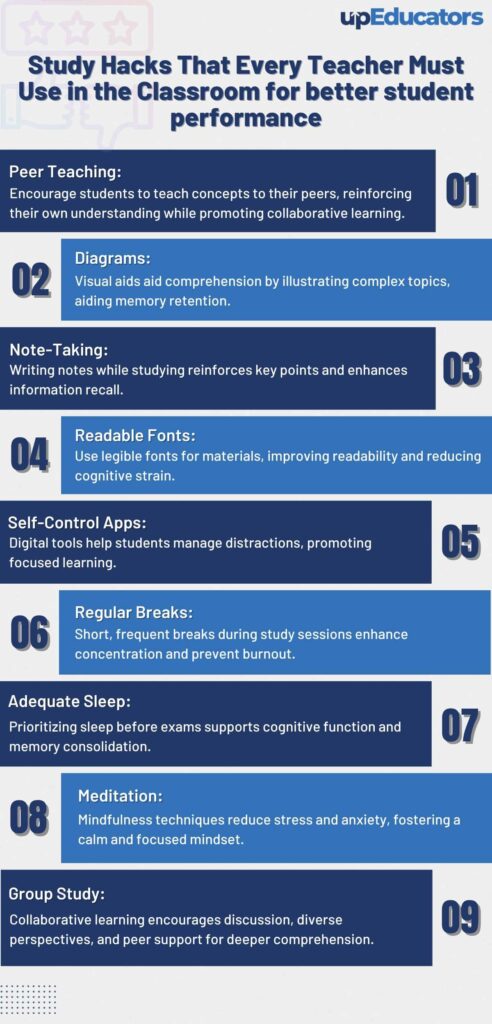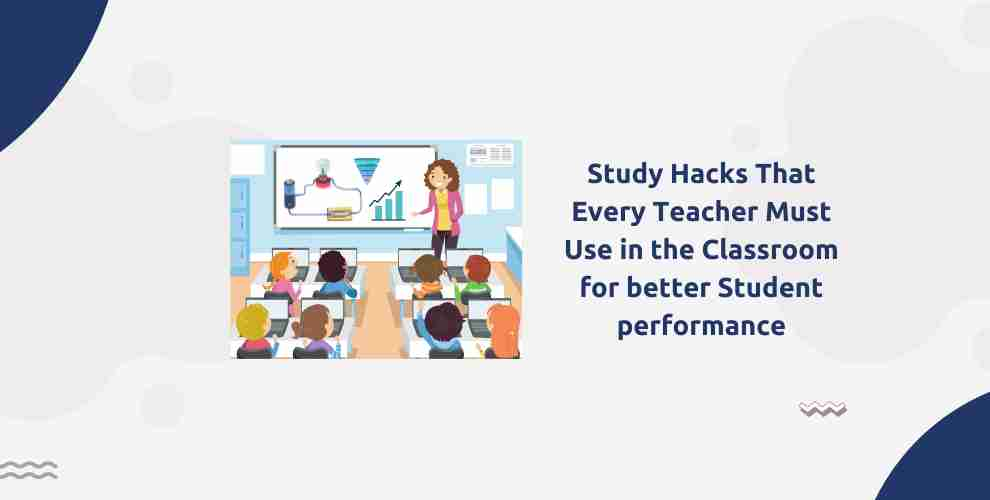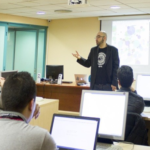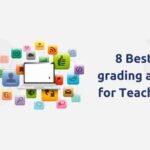Ms Jeny, an innovative teacher, aimed to boost her student’s academic success by introducing study hacks like meditation, breaks, and group study. She initiated each class with a short meditation session, emphasizing mental clarity and focus. These moments of mindfulness helped students engage better during lessons.

Recognizing the importance of breaks in maintaining productivity, Ms Jeny incorporated regular short breaks into the day. Students were encouraged to relax their minds through socializing, reading, or listening to music, ensuring they returned to their studies refreshed and motivated.
Additionally, Ms Jeny promoted group study sessions, understanding the benefits of collaboration and peer learning. Group projects and discussions allowed students to tap into the collective knowledge, reinforcing their understanding and developing teamwork skills. The students’ performance significantly improved over time, as they became more attentive, retained information better, and showed increased motivation.
Such study hacks may seem like small changes but they make a significant difference. In this blog, we discuss such study hacks shared by thousands of teachers from different levels and backgrounds trained by our expert trainers at upEducators.
Teaching what you have learnt
One effective technique for students to enhance their memory and reinforce their learning is by teaching the material to others. When students take on the role of a teacher, they engage in a process referred to as “learning by teaching.” This approach involves explaining concepts, addressing inquiries, and organizing information in a coherent manner, which necessitates a strong grasp of the subject matter.
By teaching others, students actively retrieve and articulate the information, thereby improving their own understanding and retention. It compels them to break down complex ideas into simpler terms and identify essential points, solidifying their knowledge. Additionally, teaching enables students to approach the material from a different angle, leading to deeper insights and connections. Teachers should thus incorporate and encourage this strategy in the classroom
Drawing diagrams
Drawing diagrams or graphs is a highly effective strategy for students to enhance memory retention and comprehension of complex concepts. By creating visual representations, students engage in “visual encoding,” facilitating information processing and recall.
Drawing diagrams or graphs allows students to transform abstract ideas into tangible visuals, making the information more accessible and understandable. It enables them to visually organize and connect key elements, leading to a deeper understanding of the relationships between concepts. Active participation in creating these visuals also improves retention.
Moreover, visual representations cater to different learning styles, particularly benefiting visual learners. Diagrams and graphs provide a comprehensive overview, facilitating pattern recognition, connections, and efficient information retrieval. Teachers should thus employ this strategy for better learning in the classroom.
Making notes while reading a topic
The act of writing down information engages multiple cognitive processes, enhancing comprehension and recall.
When students make notes, they actively process the material, selecting and summarising key points in their own words. This process requires them to think critically about the content and extract the most relevant information, leading to a deeper understanding of the topic. Moreover, the act of writing stimulates kinesthetic learning, where the physical movement of writing reinforces memory retention. Thus, teachers must adopt this strategy in the classroom.
Use easy-to-read fonts
The choice of font significantly impacts students’ ability to remember and comprehend information. Using easy-to-read fonts is an effective strategy for enhancing memory retention and understanding. Legible fonts, like Arial or Times New Roman, reduce cognitive load, allowing students to focus on the content.
Clear letterforms and sufficient spacing improve readability and reduce eye strain. Fluent reading facilitated by legible fonts promotes better comprehension and memory retention as students can allocate mental resources to understanding rather than deciphering text. Easy-to-read fonts also benefit students with reading difficulties, enhancing accuracy and comprehension.
Teachers should themselves use and encourage the use of legible fonts for notes, assignments and other materials.
Use self-control apps
By utilizing self-control apps, students can resist the temptation of unproductive online behaviours, such as social media or gaming, during study sessions. Website blockers restrict access to distracting sites, enabling students to concentrate on their learning materials. Timers assist in setting study periods and breaks, establishing a structured and efficient study routine.
Furthermore, self-control apps provide students with insights into their study habits and time management skills. Activity tracking features enable them to monitor progress, identify areas for improvement, and adjust study strategies accordingly. This self-awareness empowers students to take charge of their learning process and make informed decisions about their study habits.
Get regular breaks
Regular breaks are crucial for students to enhance their learning experience and academic performance. By incorporating breaks during study sessions, students can recharge their mental energy, consolidate information, and improve focus and productivity.
Continuous studying without breaks can lead to decreased concentration, resulting in reduced retention and comprehension. Regular breaks help prevent mental fatigue and maintain optimal cognitive abilities. They allow the brain to process and solidify learned information, enhancing long-term memory retention.
Teachers should thus integrate regular breaks during the classroom to ensure better learning.
Get good sleep before the exam and meditate
Getting sufficient sleep before an exam and incorporating meditation into students’ routines are powerful strategies for improving learning outcomes. Adequate sleep allows the brain to consolidate information, enhance memory retention, and improve cognitive functions essential for optimal performance.
During sleep, the brain processes and organizes newly acquired information, strengthening neural connections and facilitating better recall. Students who prioritize quality sleep are more likely to retain information, exhibit improved problem-solving abilities, and demonstrate sharper focus during exams.
Meditation is another valuable practice for enhancing learning. Regular meditation sessions help students manage stress, increase self-awareness, and improve mental clarity. By practising mindfulness, students cultivate the ability to focus their attention on the present moment, reducing distractions and improving concentration. This enables them to engage more fully in their studies, absorb information more effectively, and retain knowledge for longer periods.
Group study
Group study is an effective strategy for enhancing students’ learning experience and academic performance. It enables students to actively discuss and explain concepts to one another, deepening their understanding and gaining new perspectives. Group study fosters critical thinking, problem-solving skills, and the ability to analyze information from different angles through interactive engagement and participation. It also promotes teamwork, communication, and time management skills by allowing students to divide tasks and collaborate on complex assignments or projects.
Teachers should encourage group study in the classroom as it creates a collaborative learning environment that enhances classroom dynamics and fosters a sense of community among students.
Implementing effective study hacks in the classroom is crucial for enhancing student performance and fostering a positive learning environment. Using simple strategies like group study, meditation and using productivity enhancement apps and tools can help students and teachers in learning and teaching better.
Author: This article is written by Samiya Rashid for upEducators blog.




